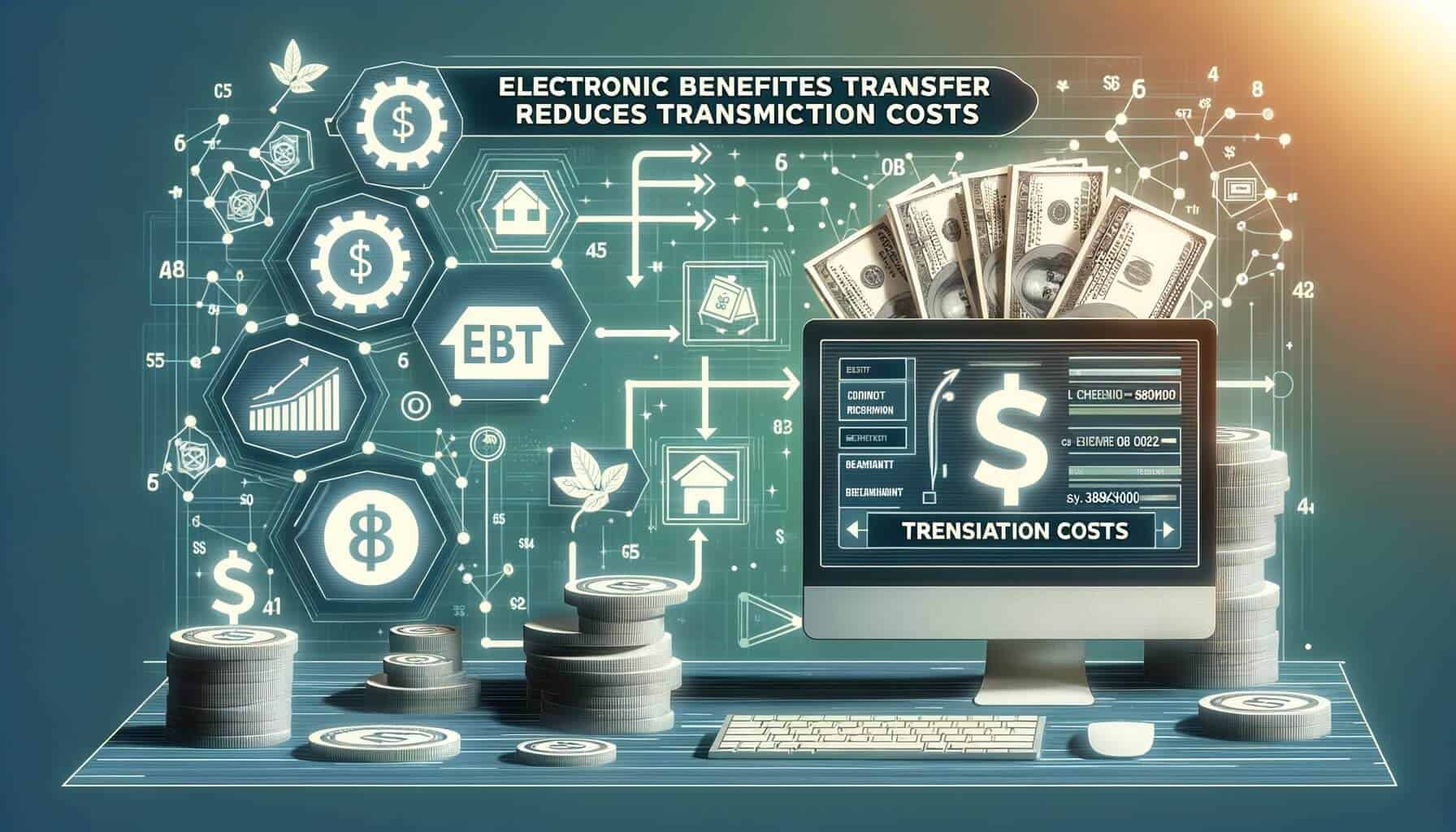
By Sharon Watson January 31, 2025
In today’s digital age, payment processing has become an integral part of any business operation. Whether it’s a small local store or a large multinational corporation, the ability to accept electronic payments is crucial for success. One such payment method that has gained significant popularity in recent years is Electronic Benefit Transfer (EBT) payment processing.
EBT payment processing allows merchants to accept payments from customers who receive government assistance benefits such as SNAP (Supplemental Nutrition Assistance Program) or TANF (Temporary Assistance for Needy Families). In this comprehensive guide, we will explore how EBT payment processing reduces transaction costs for merchants and provides a seamless payment experience for customers.
Understanding Transaction Costs in Payment Processing
Before delving into the benefits of EBT payment processing, it is essential to understand the concept of transaction costs in payment processing. Transaction costs refer to the expenses incurred by businesses when accepting and processing payments. These costs can include interchange fees, processing fees, chargeback fees, and other associated expenses.
For merchants, reducing transaction costs is crucial as it directly impacts their profitability and bottom line. EBT payment processing offers several advantages that help minimize these costs, making it an attractive option for businesses.
Benefits of EBT Payment Processing for Merchants

1. Reduced Interchange Fees: Interchange fees are charges imposed by card networks such as Visa or Mastercard for processing transactions. These fees can vary depending on the type of card used and the transaction amount. EBT payment processing typically incurs lower interchange fees compared to traditional credit or debit card transactions, resulting in cost savings for merchants.
2. Lower Processing Fees: In addition to interchange fees, payment processors also charge processing fees for handling transactions. EBT payment processing providers often offer competitive pricing structures, allowing merchants to benefit from lower processing fees compared to other payment methods.
3. Increased Customer Base: By accepting EBT payments, merchants can tap into a broader customer base. Government assistance programs like SNAP and TANF serve millions of individuals and families across the country. By accommodating these customers, businesses can attract new clientele and increase sales.
4. Streamlined Payment Process: EBT payment processing offers a seamless and efficient payment experience for both merchants and customers. The process is straightforward, with customers swiping their EBT cards and entering a PIN to complete the transaction. This simplicity reduces the time spent on payment processing, allowing businesses to serve more customers in less time.
5. Enhanced Security: EBT payment processing utilizes secure encryption and authentication protocols to protect sensitive customer data. This ensures that transactions are conducted securely, reducing the risk of fraud or data breaches. By offering a secure payment method, merchants can build trust with their customers and safeguard their reputation.
How EBT Payment Processing Works: A Step-by-Step Guide
Now that we have explored the benefits of EBT payment processing let’s dive into how it works. Understanding the step-by-step process will provide merchants with a comprehensive understanding of how to integrate EBT payment processing into their business operations.
1. Merchant Setup: The first step is for the merchant to set up an EBT payment processing account with an authorized provider. This involves completing an application, providing necessary documentation, and agreeing to the terms and conditions.
2. Equipment Acquisition: Once the account is set up, merchants need to acquire the necessary equipment to accept EBT payments. This typically includes a point-of-sale (POS) terminal or a compatible card reader that can process EBT transactions.
3. Integration and Testing: After acquiring the equipment, merchants need to integrate it with their existing POS system or software. This integration ensures that EBT payments can be seamlessly processed alongside other payment methods. Once integrated, thorough testing should be conducted to ensure the system is functioning correctly.
4. Customer Payment: When a customer wishes to make a purchase using their EBT card, the merchant initiates the transaction by swiping the card through the card reader or POS terminal. The customer is then prompted to enter their PIN to authorize the payment.
5. Authorization and Approval: The payment processor verifies the customer’s EBT card details and checks the available balance. If the transaction is approved, the payment processor sends an authorization code to the merchant, indicating that the payment has been authorized.
6. Settlement and Funding: Once the transaction is authorized, the payment processor initiates the settlement process. This involves transferring the funds from the customer’s EBT account to the merchant’s designated bank account. The settlement process typically takes a few business days, depending on the payment processor and the merchant’s bank.
Key Features and Technologies in EBT Payment Processing

EBT payment processing relies on various features and technologies to ensure a smooth and secure payment experience. Understanding these key features will help merchants make informed decisions when selecting an EBT payment processing provider.
1. EBT Card Compatibility: EBT payment processing providers offer equipment and software that are compatible with EBT cards issued by government assistance programs. Merchants must ensure that the provider they choose supports the specific EBT card types used by their target customer base.
2. Secure Encryption: To protect sensitive customer data, EBT payment processing utilizes secure encryption protocols. This ensures that payment information is transmitted securely between the merchant, payment processor, and card networks.
3. Real-Time Authorization: EBT payment processing systems provide real-time authorization, allowing merchants to quickly verify the customer’s EBT card details and available balance. This ensures that transactions are processed efficiently and reduces the risk of accepting payments from invalid or expired EBT cards.
4. Reporting and Analytics: EBT payment processing providers often offer robust reporting and analytics tools. These tools allow merchants to track and analyze transaction data, gain insights into customer behavior, and make informed business decisions.
5. Integration with Existing Systems: Seamless integration with existing POS systems or software is crucial for efficient EBT payment processing. Merchants should choose a provider that offers easy integration options and provides technical support if needed.
Reducing Transaction Costs with EBT Payment Processing: Strategies and Best Practices

While EBT payment processing offers inherent cost-saving benefits, there are additional strategies and best practices that merchants can implement to further reduce transaction costs.
1. Negotiate Processing Fees: When selecting an EBT payment processing provider, merchants should negotiate processing fees to ensure they are getting the best possible rates. Providers may be willing to offer discounted rates based on the merchant’s transaction volume or other factors.
2. Optimize Payment Processing Infrastructure: Merchants should regularly review their payment processing infrastructure to identify any inefficiencies or bottlenecks. Upgrading hardware, software, or network capabilities can improve transaction processing speed and reduce associated costs.
3. Minimize Chargebacks: Chargebacks can be costly for merchants, as they often incur fees and can result in lost revenue. By implementing robust fraud prevention measures and providing excellent customer service, merchants can minimize chargebacks and associated costs.
4. Educate Staff and Customers: Properly trained staff can help streamline the payment process and reduce errors, leading to cost savings. Merchants should also educate customers on the proper use of EBT cards to minimize transaction errors and potential chargebacks.
Common Challenges and Solutions in EBT Payment Processing

While EBT payment processing offers numerous benefits, there are some common challenges that merchants may encounter. Understanding these challenges and implementing appropriate solutions can help ensure a smooth payment experience for both merchants and customers.
1. Technical Issues: Technical issues such as equipment malfunctions or software glitches can disrupt the payment process. Merchants should choose reliable equipment and software providers and have a contingency plan in place to address any technical issues promptly.
2. Connectivity Problems: In some cases, merchants may face connectivity issues, especially in remote or rural areas. Merchants should consider backup connectivity options, such as mobile data or alternative internet service providers, to ensure uninterrupted payment processing.
3. Compliance and Regulation: EBT payment processing is subject to specific compliance and regulatory requirements. Merchants must stay updated on these requirements and ensure that their payment processing systems adhere to all applicable rules and regulations.
4. Customer Education: Some customers may be unfamiliar with using EBT cards for payment or may have questions about the process. Merchants should provide clear instructions and educate customers on how to use their EBT cards to minimize confusion and potential errors.
Comparing EBT Payment Processing Providers: Factors to Consider
When selecting an EBT payment processing provider, merchants should consider several factors to ensure they choose the right partner for their business. Here are some key factors to consider:
1. Pricing Structure: Merchants should compare the pricing structures of different EBT payment processing providers to find the most cost-effective option. This includes considering interchange fees, processing fees, and any additional charges.
2. Equipment Compatibility: Merchants should ensure that the provider’s equipment and software are compatible with their existing POS systems or software. Compatibility issues can lead to inefficiencies and additional costs.
3. Customer Support: Reliable customer support is crucial for resolving any technical issues or addressing concerns promptly. Merchants should choose a provider that offers responsive customer support and technical assistance.
4. Security Measures: Merchants should prioritize security when selecting an EBT payment processing provider. Providers should offer robust encryption protocols, fraud prevention measures, and compliance with industry security standards.
Frequently Asked Questions (FAQs) about EBT Payment Processing
Q1. What is EBT payment processing?
EBT payment processing allows merchants to accept payments from customers who receive government assistance benefits such as SNAP or TANF. It offers a seamless and efficient payment experience for both merchants and customers.
Q2. How does EBT payment processing reduce transaction costs?
EBT payment processing reduces transaction costs by offering lower interchange fees, lower processing fees, and streamlined payment processes. It also helps attract a broader customer base, increasing sales potential.
Q3. What are the key features of EBT payment processing?
Key features of EBT payment processing include EBT card compatibility, secure encryption, real-time authorization, reporting and analytics tools, and seamless integration with existing systems.
Q4. How can merchants reduce transaction costs with EBT payment processing?
Merchants can reduce transaction costs by negotiating processing fees, optimizing payment processing infrastructure, minimizing chargebacks, and educating staff and customers.
Conclusion
EBT payment processing offers numerous benefits for merchants, including reduced transaction costs, increased customer base, streamlined payment processes, and enhanced security. By understanding the key features, technologies, and best practices associated with EBT payment processing, merchants can make informed decisions and optimize their payment processing operations. While challenges may arise, proper planning and selecting the right EBT payment processing provider can help overcome these obstacles. By embracing EBT payment processing, merchants can improve their profitability, attract new customers, and provide a seamless payment experience for all.